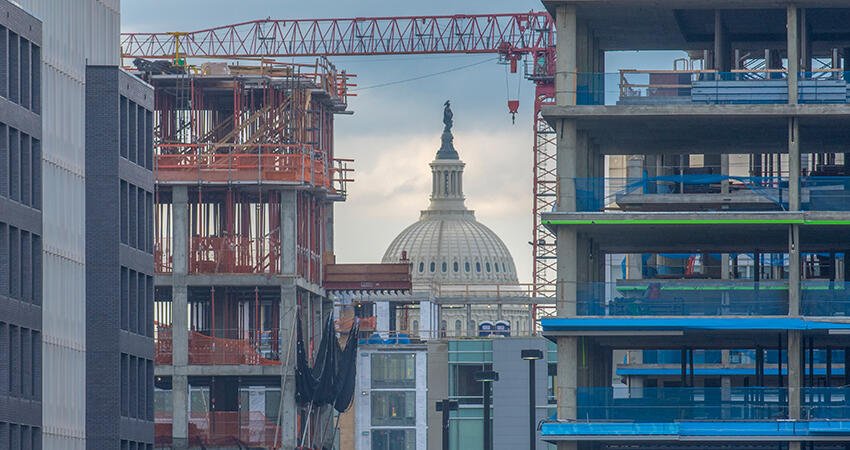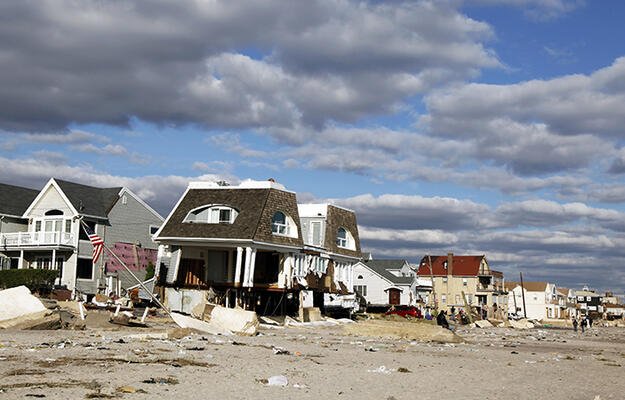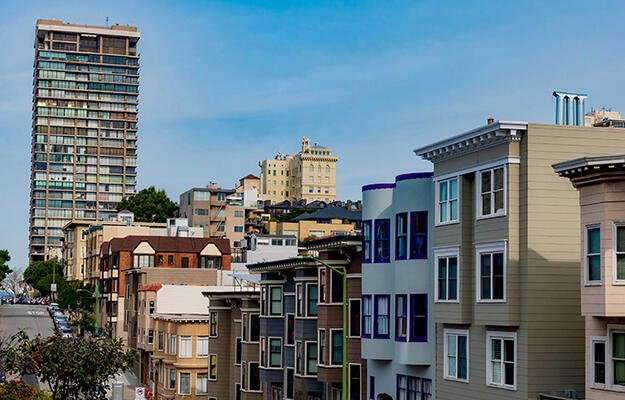
(TJ Brown / Shutterstock)
Three Ways Local Policymakers Can Confront Development-Directed Policing in Washington, DC
Evidence shows that in gentrifying neighborhoods, police help drive displacement by proactively protecting and responding to the priorities of newer residents and businesses, who are disproportionately white and more affluent than long-term residents, and surveilling and criminalizing the behaviors of long-term residents, who are disproportionately Black and Latinx. This phenomenon is known as development-directed policing.
Until the mid-20th century, lenders, real estate agents, white residents, and elected leaders explicitly blocked people of color from opportunities to own property, build wealth, and occupy the most-resourced neighborhoods by codifying racist exclusion into law and perpetuating it via racially restrictive covenants, redlining, and blockbusting.
Today, housing and neighborhood outcomes (as measured by residential segregation, exclusionary zoning policies, the Black-white homeownership and appraisal gaps, and documented discrimination by real estate agents) signal that structural racism in housing persists. Simultaneously, policymakers and elected officials use police forces, which emerged from patrols that tracked and captured enslaved people, to assert social control in majority-Black communities (PDF) and criminalize Blackness. This history is critical for understanding that by prioritizing market and property interests, police further serve the interests of white, more affluent residents and businesses—a trend clearly apparent in DC.
In the District of Columbia, rising property values and rents, the growth of the police budget, and the disproportionate rates of both displacement and low-level arrests among Black residents raise red flags that city leaders, developers, homeowners, and new residents enable and encourage development-directed policing to protect market interests.
To learn more about development-directed policing in DC, we spoke with Brenden Beck, a researcher from the University of Colorado, Denver, whose research explores the connection between housing markets and policing; Tazra Mitchell and Eliana Golding, researchers from the DC Fiscal Policy Institute with expertise in the district’s budget process; and Patrick Gregoire, a right-to-housing organizer with ONE DC.
What does development-directed policing look like in DC?
Although researchers have not explicitly studied development-directed policing in DC, several trends from the data and our conversations with local experts raise red flags about the relationship between low-level policing, gentrification, and displacement in the district. They include the following:
- High rates of displacement: Between 2000 and 2010, more than 20,000 Black residents in DC were displaced. And in the past five years, 16 percent of DC neighborhoods with lower property values and lower-income residents gentrified, making it one of the top 15 most intensely gentrified cities in the US. The COVID-19 pandemic and resulting economic recession are only accelerating the racialized trends of displacement. The Aspen Institute estimates between 118,000 and 131,000 people are at risk of eviction in DC, many of whom are Black families, who have experienced the greatest levels of economic hardship because of the pandemic.
- Frequent stops and low-level arrests among Black residents: DC is among the most-policed jurisdictions in the country, and although Black people make up 46 percent of the city’s population, roughly 70 percent of police stops, 90 percent of stop and frisks, and 89 percent of reported use of force incidents involve a Black person. Gregoire believes “police are instrumental in the process of gentrification in DC,” and areas primed for gentrification usually see a surge in low-level, “quality of life” charges. Increased police stops, even when a person is not incarcerated, burden residents through fines, court hearings, proceedings, and risk of police violence. Gregoire says this makes it hard for people to maintain their jobs, families, and housing stability, which can lead to people feeling pressured to leave their neighborhood to live their lives with less surveillance and harassment.
- Growth in Metropolitan Police Department’s (MPD’s) budget: The MPD budget has increased by 12 percent since 2015 and, with an approved gross budget of $562,000,000 for 2021, is larger than each of the budgets for affordable housing, employment services, and physical and behavioral health. About 90 percent of the MPD budget goes to “personnel services” like salaries and benefits to support DC’s nearly 4,000-person police force, rather than “nonpersonnel services” like communications and recruitment costs. Golding says, “When talking to advocates, what I learned is that [defunding] will turn into a fight with the police union. If we are to meaningfully decrease the amount of money that goes to police, it’s really a personnel issue.” DC has approximately 55 officers per 10,000 residents, which is double the national average.
- Police favor new residents and business: In February 2016, mayor Muriel Bowser launched the Private Security Camera Incentive Program. Reports show that program participation, which requires that the camera be registered with the MPD, is significantly higher among businessowners and residents in gentrifying wards. Two summers ago, #DontMuteDC gained national attention after new residents of a Shaw luxury apartment complex filed consistent complaints about a local business playing go-go music, prompting antigentrification protests. And last winter, the MPD swept unsheltered encampments in the NoMa neighborhood at the request of new businesses. As Gregoire explains, “New businesses are aimed at new residents with disposable income. But who is working there? Who is serving? It’s the same Black residents who are being policed and controlled for behaviors that people do to eat, keep a roof over their head, make ends meet.”
How can policymakers address development-directed policing?
The experts we spoke with suggested a range of actions policymakers could take to mitigate the immediate harms caused by development-directed policing, shift power to people who are most harmed by these oppressive structures, and invest in systems of care that support the needs of long-term residents.
- Address the immediate harms of policing and housing insecurity
To mitigate the harms of development-directed policing and prevent displacement, Beck suggested policymakers can start by repealing nuisance ordinances and reducing misdemeanor arrests and stops that are exacerbating housing instability and incarceration across DC. Evidence shows nuisance property ordinances disproportionately target Black residents and residents with mental illnesses and can empower and encourage landlords to evict tenants because of biased or unwarranted police enforcement at a property. Repealing these ordinances would prevent punishing people because they have fewer resources. Gregoire also urged policymakers to relieve the rent burden for households to prevent another massive wave of displacement in DC. Policies like cancelling rent and equitably administering rental assistance will be critical to securing immediate housing stability for Black and Latinx renters.
- Follow the lead of organizers in communities directly affected by development-directed policing
To stop development-directed policing, the people most affected must lead. Mitchell and Golding encourage DC policymakers to center the voices of people most affected by displacement and policing in the annual budget-making process and the planning process for the 10-year comprehensive plan. Community leadership and input on these processes will be critical to developing the solutions that can curb police-related violence and displacement and address long-standing spatial inequities in DC. Gregoire emphasized that researchers and policymakers must reckon with the “fact that the people who work on [these issues in policy] are not those impacted by it. There’s no way this is getting better unless people being impacted are at every single table where decisions are being made about this.”
- Defund the police, invest in housing
Community activists such as Stop Police Terror Project DC and the Defund MPD Coalition are pushing for local governments to defund the police and instead invest those resources in education, housing, and health services. Golding offered a couple of budget approaches that could build on community groups’ work to address both displacement and policing. First, policymakers could consider moving operating expenses from the MPD budget to pay for additional tenant services staff time to help residents take advantage of existing legal protections and to fund legal services to prevent eviction and displacement, especially in the wake of the pandemic. Second, policymakers could consider moving money from MPD to fund deeply affordable housing, which contributes to community safety by strengthening resident stability. Both Beck and Gregoire add that preventing displacement requires strengthening and enforcing tenant protections and empowering tenants to take advantage of right to stay laws, like the Tenant Opportunity to Purchase Act. Strategically shifting funds from MPD to invest in these types of housing preservation and protection activities could help mitigate the harm from development-directed policing.
These priorities represent a starting point to begin confronting structural links between displacement and policing, but as Gregoire points out, combating development-directed policing in DC is “going to be a lot of protracted fighting on multiple fronts; it’s a narrative fight, a resource fight, an optics fight.” He added, “There’s no way to get this done politely while wearing a suit and reading over white papers—that’s an important part of the process but that’s all it is—one part.”


